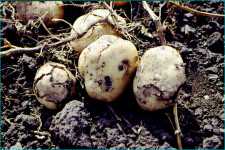Latest News On Bacterial Ring Rot Detection

Bacterial ring rot of potato (BRR) is a disease that is usually very difficult to see in seed potatoes, yet can cause significant losses when it shows up in a commercial crop. Because of its explosive nature and the damage it can cause, this disease is one of the most feared in all of potato production, especially by seed producers. Recently, however, some techniques have been developed to detect this disease that may help the industry get the upper hand in our long-term battle with BRR.
BRR, caused by the bacterium Clavibacter michiganensis subsp. sepedonicus, infects the vascular tissues of both foliage and tubers. The foliar symptom of BRR in the field is a wilt, as you would expect from a vascular pathogen. Tuber symptoms range from a slight yellowish discoloration of the vascular ring to the complete deterioration of the vascular tissues. External tuber cracking is another common symptom and is often the first indication to many growers that BRR is present in their crop. The disease also has an unfortunate tendency to remain symptomless (latent) in seed potatoes, which is probably one of the main reasons BRR has remained a problem after all these years.
Management Options
Managing BRR is accomplished primarily through strict seed certification regulations which classify BRR as a “zero tolerance disease,” meaning the discovery of a single plant in the field or a single tuber in storage means immediate rejection of the entire seed lot. For better or for worse, all seed certification agencies in the U.S. still rely on visual evaluation of the seed crop to determine BRR presence. Visual evaluation, along with the limited generation system of seed certification, have been adequate to keep the disease mostly in check.
However, all too often BRR tends to “flare up” causing local and regional outbreaks on about a five to eight-year cycle. The reasons for these periodic outbreaks are not completely understood, but a lack of proper sanitation procedures during cutting and handling seed potatoes is likely a major contributor. Here’s how we believe the cycle occurs: A BRR flare-up takes place causing people in the industry to respond by getting serious about their sanitation procedures.
Every piece of equipment and all storage facilities on the affected farms are subjected to a thorough sanitation program. These methods generally prove to be effective in eliminating the disease, thus minimizing the BRR threat. Thinking that the problem is solved, the industry gradually eases off, becoming more and more lax about sanitation over a period of several years, which, in turn, leads to another outbreak. The ensuing crackdown on the disease in the form of more stringent sanitation practices sends the disease into hiding again.
Lather, rinse, and repeat. Needless to say, an effective, constantly applied sanitation program is a vital part of long-term BRR management.
Over the last several years, some new laboratory techniques have been developed that vastly improve our ability to detect the latent infections of this disease. The increasing availability of Polymerase Chain Reaction (PCR) technology has the potential to change the game completely. With a PCR test performed on samples of 4,400 tubers or more, it is now possible to find more than 99% of the BRR-infected seed lots, most of which would have previously gone undetected!
Currently these new testing procedures are not mandated by any of the nation’s certification agencies. While this situation may change sometime in the future, for now, all testing is being performed on a voluntary basis. If you have concerns about BRR, I suggest that you strongly consider having your seed sources tested using these modern methods at these very high tuber number samples.










